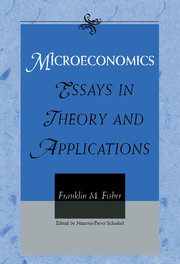Book contents
- Frontmatter
- Contents
- Introduction
- Part I Disequilibrium and Stability
- Part II Welfare Economics and Consumer Theory
- Part III Applications of Microeconomic Theory
- Part IV Industrial Organization, Economics, and the Law
- Part V Public Policy Applications
- 29 Standing Up to Be Counted: The Decision not to Adjust the 1990 Census (1994)
- 30 The Economics of Water Dispute Resolution, Project Evaluation and Management: An Application to the Middle East (1995)
- Epilogue
- Indexes
29 - Standing Up to Be Counted: The Decision not to Adjust the 1990 Census (1994)
Published online by Cambridge University Press: 20 March 2010
- Frontmatter
- Contents
- Introduction
- Part I Disequilibrium and Stability
- Part II Welfare Economics and Consumer Theory
- Part III Applications of Microeconomic Theory
- Part IV Industrial Organization, Economics, and the Law
- Part V Public Policy Applications
- 29 Standing Up to Be Counted: The Decision not to Adjust the 1990 Census (1994)
- 30 The Economics of Water Dispute Resolution, Project Evaluation and Management: An Application to the Middle East (1995)
- Epilogue
- Indexes
Summary
Introduction
It has long been well known that the decennial census of population systematically undercounts certain groups not only absolutely but in relation to the population as a whole. Those groups tend to be black or Hispanic and/or poor. The reasons for this are not hard to find: (1) Some members of such groups tend to distrust government and tend not to want to be found; (2) illiteracy rates are higher in such groups and addresses uncertain, making mail-back techniques unreliable; and (3) the neighborhoods in which those groups live often do not seem inviting or safe to census takers, leading to less accurate follow-ups. In any event, the fact of differential undercount has long been documented. The effects are important in a democratic society. First, the distribution of seats in the House of Representatives depends on the Census. This means that states with a high proportion of the undercounted groups may receive less representation in Congress than that to which they are entitled. Second, the distribution of federal funds to the states is affected. Third, if the census figures are relied on within states for apportionment purposes, rural and suburban areas will receive more representation in state legislatures than that to which they are really entitled, and urban areas – particularly inner-city areas – will receive less.
It should not (and typically does not) escape attention that these matters have partisan consequences. As a general matter, urban areas tend to vote Democratic. Further, state legislatures apportion districts for Congressional elections. Hence, not only does the differential undercount disenfranchise minorities and the poor, it also aids the Republican party.
- Type
- Chapter
- Information
- MicroeconomicsEssays in Theory and Applications, pp. 487 - 518Publisher: Cambridge University PressPrint publication year: 1999



